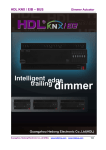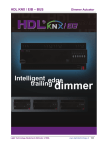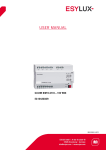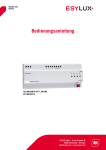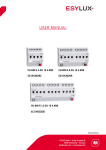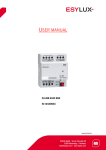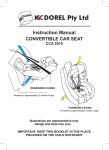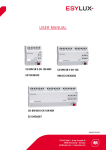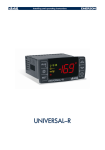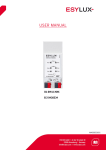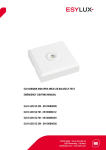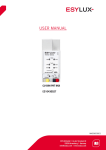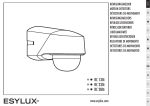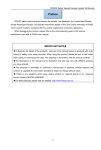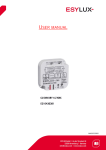Download 4.2 Dimming mode
Transcript
USER MANUAL CU-DIN DIM 4-CH 1.5A KNX EC10430312 MA00651301 USER MANUAL Table of contents 1 Description ................................................................................................3 2 Safety instructions ......................................................................................3 3 Product function ........................................................................................4 4 Hardware...................................................................................................4 4.1 4.2 4.3 4.4 4.5 5 Software ..................................................................................................10 5.1 5.2 5.3 5. 4 5.5 6 Technical data ................................................................................ 4 Dimming mode ............................................................................... 7 4.2.1 Trailing edge dimming mode ................................................. 7 4.2.2 Leading edge dimming mode ................................................ 7 4.2.3 Changing dimming mode ...................................................... 8 Dimensional drawings ...................................................................... 8 Wiring diagram ............................................................................... 9 Maintenance and cautions .............................................................. 10 Overview of database functions ....................................................... 11 Object/Association/Group address definition ..................................... 11 “General” function parameter ......................................................... 12 Channel “N” function parameter ..................................................... 16 A>dimming config ......................................................................... 24 5.6 A: function........................................................................ 26 5.6.1 A: “Staircase light” function ............................................... 27 5.6.2 A: “Flashing” function ....................................................... 29 5.6.3 A: “Scene” function ........................................................... 31 5.6.4 A: “Threshold” function ..................................................... 32 5.6.5 A: “Heating” function ........................................................ 34 Communication objects description ............................................................36 6.1 6.2 6.3 6.4 6.5 6.6 6.7 6.8 6.9 “General” objects .......................................................................... 36 “Channel N output” objects............................................................ 36 “Respone” objects ........................................................................ 37 “Statistics ON time” objects ........................................................... 38 “Temperature” objects ................................................................... 38 “Staircase light” objects ................................................................ 39 “Flashing” objects ......................................................................... 39 “Scene” objects ............................................................................ 40 “Threshold” objects ....................................................................... 41 CU-DIN DIM 4-CH 1.5A KNX 1 / 44 USER MANUAL 6.10 “Heating” objects.......................................................................... 41 7 Application ..............................................................................................43 7.1 Program functions diagram ............................................................. 43 8 Product disposal ......................................................................................44 9 ESYLUX manufacturer´s guarantee .............................................................44 CU-DIN DIM 4-CH 1.5A KNX 2 / 44 USER MANUAL 1 Description The ESYLUX CU-DIM 4-CH 1.5A KNX uses KNX/EIB BUS to communicate with other KNX devices. The database must be downloaded to the dimmer actuator VD4 AB version, as well as the description document on how to use these products. Our products are compliant with standards for electromagnetic compatibility (EMC), electrical safety and environmental conditions. The dimmer actuator control a number of loads, including: Lighting Motor Curtain Heating Other equipment Note: Use this product only as intended (as described in the user instructions). Do not make any changes or alterations as this will render any warrantees null and void. You should check the device for damage immediately after unpacking it. If there is any damage, you should not install the device under any circumstances. If you suspect that safe operation of the device cannot be guaranteed, you should turn the device off immediately and make sure that it cannot be operated unintentionally. 2 Safety instructions Work on the 230 V power system must be carried out by authorized personnel only, with due regard to the applicable installation regulations. Switch off the power supply before installing the system. The 21 – 30 V KNX bus voltage cannot be used as 24 V DC operating or auxiliary voltage. Max. dimmer output: 1.5 A CU-DIN DIM 4-CH 1.5A KNX 3 / 44 USER MANUAL 3 Product function The dimmer actuator can dim over one, two, four or six channels independent of AC load. Each channel output has maximum 1.5A current for dimmer 4fold actuator and cannot exceed 6A of total current. The following functions can be set individually for each output channel: Total ON time statistics Response status Recovery status Over-temperature protection Read temperature Over-temperature alarm Staircase light Flashing light Scene control Scene dimming Sequence control Threshold switch Heating actuator (PWM) 4 Hardware Technical characteristic of ESYLUX KNX/EIB Dimmer actuators are discussed in the following sections. 4.1 Technical data Power supply Operating voltage (supply by the bus) 21–30 V Current consumption EIB/KNX (operate) <15 mA Current consumption <5 mA CU-DIN DIM 4-CH 1.5A KNX 4 / 44 USER MANUAL EIB/KNX(standby) Power consumption EIB/KNX(operate) <450 mW Power consumption EIB/KNX(standby) <150 mW Nominal output values Number of contacts 4 In rated current 1.5 A Power loss per device at max. load 8W In rated voltage 230 V~ Output life expectancy Mechanical life 50 years Electrical life 20 years Dimmer actuator output without additional DC power Connections EIB/KNX Bus connection terminal 0.8 mm Ø, single core Load circuits Screw terminal with slotted head 0.2–4 mm² multi-core 0.4–6 mm² single core Cable shoe 12 mm Tightening torque Max. 0.8 Nm Operation and display Red LED and EIB/KNX program button for assignment of the physical address. Temperature range Operation -5°C to +45° C Storage -25°C to +55° C Transport -25°C to +70° C Environmental conditions Humidity CU-DIN DIM 4-CH 1.5A KNX max. 95% Noncondensing 5 / 44 USER MANUAL Appearance design Modular DIN rail modular installation Dimensions (H x W x D) 90 x 216 x 65 Width W (mm) 216 Mounting width (1P=18 mm) 12P Mounting depth (mm) 65 Weight (kg) 0.49 Installation use 35-mm mounting rail Mounting position Electric dimmer box Material and colour Plastic, White CE Mark in accordance with EMC Standard 2004/1008/EC LVD Standard 2006/95/EC RoHS 2011/65/EU Note: All loads, at 230 V ~ Programming requires the EIB Software Tools ETS3.0E Max. number of communication objects 90 Max. number of group addresses 254 Max. number of associations 254 CU-DIN DIM 4-CH 1.5A KNX 6 / 44 USER MANUAL 4.2 4.2.1 Dimming mode Trailing edge dimming mode If in trailing edge dimming mode, the red LED lashes for five seconds at power on. Note: This mode should be used for resistive and capacitive loads. For example. Tungsten halogen lamp – mains voltage, incandescent lamp and low-voltage tungsten halogen lamps with electronic transformers. 4.2.2 Leading edge dimming mode If in leading edge dimming mode, the red LED flashes for five seconds at power on. Note: This mode should be used for Inductive and resistive loads. For example Tungsten halogen lamp – mains voltage, incandescent lamp, lowvoltage tungsten halogen lamps with conventional transformers and motors. CU-DIN DIM 4-CH 1.5A KNX 7 / 44 USER MANUAL 4.2.3 Changing dimming mode Press the grey buttons simultaneously to change the dimming mode. The LED button flashes for five seconds. Note: Press and hold the first and last buttons simultaneously to toggle between leading edge dimming mode and trailing edge dimming mode. 4.3 Dimensional drawings CU-DIN DIM 4-CH 1.5A KNX 8 / 44 USER MANUAL 4.4 Wiring diagram Note: On the input side, the device is to be protected against short circuits with a 6 A circuit breaker. 1. 2. 3. 4. 5. 6. 7. Label area Power input KNX/EIB Bus Connector Programming button and programming LED Contact position indication and manual operation LED state Terminal for load connection sequence Note: a) Dimensions of the space provided for each dimmer b) Dimensions and position of the means for supporting and fixing the dimmer within this space c) Minimum clearance between the various parts of the dimmer and the surrounding parts where fitted d) Minimum dimensions of ventilation opening, if needed, and their correct arrangement e) Protective devices (fuses, automatic protective devices, etc.) to connect to the load to prevent overload CU-DIN DIM 4-CH 1.5A KNX 9 / 44 USER MANUAL 4.5 Maintenance and cautions Please read this user manual carefully before any operation. Do not operate close to interfering devices. Use in a cool, well ventilated environment. Protect from moisture, shocks and dust. Protect from rain, liquids and caustic gases. Contact professional maintenance staff or the ESYLUX service centre for repairs. Remove dust regularly, but do not wipe the unit with volatile liquids, such as alcohol and petrol. If the unit comes into contact with moisture or liquid, switch the unit off immediately. Regularly check the circuitry and other related circuits or cables, and replace outdated circuitry in a timely manner. For safety, connect all circuits to a miniature circuit breaker (MCB) or fuse. The installation location should be well ventilated and protected from moisture, shocks and dust. 5 Software The ESYLUX KNX/EIB dimmer actuator database uses VD4 ETS 3.0e for design. The device type is CU-DIN DIM 4-CH 1.5A KNX, and the database name is Dimmer 4fold Actuator. All interfaces and functions use specific parameters. Please see the overview below. Each output channel of the dimmer actuators are independent and identical. It is therefore sufficient to understand how one operates. The following section describes the first output channel in detail. CU-DIN DIM 4-CH 1.5A KNX 10 / 44 USER MANUAL 5.1 Overview of database functions The following table provides an overview of the functions and some parameters involving switch actuators: General Cycle telegram (heartbeat) x System delay after recovery x Sequence x Channel Total ON time statistics x Recovery state voltage x Over-temperature protection x Read temperature x ON/OFF switch x Relative dimming x Absolute dimming x Scene x Scene Nos. 1–64 x Lower threshold x Middle threshold x Upper threshold x Dimming Function Threshold Heating actuator PWM x Table 1: Database application overview 5.2 Object/Association/Group address definition In the following table, objects are assigned to the same function of the output channel pages. If active, the same functions and object are valid. One or more CU-DIN DIM 4-CH 1.5A KNX 11 / 44 USER MANUAL group addresses can be assigned to an object. The association connects group addresses to the object. Type Max. number of communication objects EC10430312 90 Max. number of associations Max. number of group addresses 254 254 Table 2: Overview of the max. number of objects, max. number of associations and max. number of group addresses. 5.3 “General” function parameter Fig. 1: “General” parameter window In the general parameter window, seven parameters for “System delay after recovery” and “Cycle send general telegram and enable sequences 1–5” are available. CU-DIN DIM 4-CH 1.5A KNX 12 / 44 USER MANUAL System delay after recovery (2..255s) Delay time of 2 to 255 seconds after power on to operate relay. The default value is 2 seconds. The min. value is 2 seconds, and the max. value is 255 seconds. Options: 2…255s The timer starts at power on. At time out, dimming can be set to take place. This function is selected by the user. Cycle send general telegram (1..65535s,0-invalid) The range of the parameter is 1 to 65535 seconds. Zero disables the function; non-zero enables the function Options: 1…65535s If set to a non-zero value, the device sends telegram data cyclically at time out. Send the value alternately between 0 and 1. Enable sequence 1 Set enable for the sequence. Options: Disable Enable Disable: Disable the sequence function Enable: Enable the sequence function, set as follows CU-DIN DIM 4-CH 1.5A KNX 13 / 44 USER MANUAL Fig. 1.1: “G: sequence 1” parameter window. This includes 24 steps. Operation mode of sequence 1 Set the operation mode. Options: Start with “1”, stop with “0” Start with “0”, stop with “1” Start with “1/0”, cannot stop Start with “1”, stop with “0”: If 1 is received, run sequence 1, if 0 is received, stop sequence 1. Start with “0”, stop with “1”: If 0 is received, run sequence 1, If 1 is received, stop sequence 1. Start with “1/0”, cannot stop: If 1 or 0 is received, start sequence 1. Control mode of sequence 1 Set the control mode. Options: FWD REW Random FWD: Forward mode REW: Back work mode CU-DIN DIM 4-CH 1.5A KNX 14 / 44 USER MANUAL RANDOM: Random mode Run mode of sequence 1 Set run mode Options: Single Cycle Single: Run only ones. Cycle: Run cycle. Run time (0…255hours,0h&0m-unlimited) Set the sequence run time. Options: 0-255 Run time (0…59mins, 0h&0m-unlimited) Set the sequence run time. The longest time is 59 minutes. Options: 0-59 Note: Unlimited if the time is set to 0h&0m. Position after timeout If the sequence is running in Cycle mode and run time greater than zero, after timeout, the sequence returns to this set position. With 24 steps, the configuration is as follows: -Step 1 configuration Options: Invalid Scene No. 01 … Scene No. 64 Time for step 1 (0…65535s) Set the time for this step. The longest time is 65535 seconds. -Time for step 1 (0…999ms) Set the time for this step. The longest time is 999 milliseconds. The other steps are identical to those in step 1. CU-DIN DIM 4-CH 1.5A KNX 15 / 44 USER MANUAL 5. 4 Channel “N” function parameter Fig. 2: “Channel N” parameter (N=A,B,C...) windows Use the “Channel N” parameter windows, to set some common functions. Select the function and download the database to the device; the device will work in accordance with the selected function. Response of channel state If the dimmer is controlled, response is the result. Options: Invalid 1 bit always response 1 bit only changed 1 byte always response 1 byte only changed 1 bit always response: It always responds, If the channel is ON, response 1 If the dimmer is OFF, response 0 1 bit only changed: Response if the dimmer state has changed CU-DIN DIM 4-CH 1.5A KNX 16 / 44 USER MANUAL 1 byte always response: Always a response for the light level value. 1 byte only changed: Response if the light level value has changed. Total ON time statistics to allow (0…65535h=7.4years) Fig. 2.1: “Total ON time statistics to allow” This function is used to calculate the total ON time for channel output. The maximum time is 65535 hours. This function is very useful for knowing the channel work status. Options: Disable Enable Disable: No timing. Enable: Statistics time. Alarm at timeout (1…65535h,0-invalid) If the device's operating time reaches the set value, an alarm is triggered. The value range is 1 to 65535 hours; 0 is invalid. CU-DIN DIM 4-CH 1.5A KNX 17 / 44 USER MANUAL Transmit telegram interval at alarm Set the alarm time interval. Status after bus voltage recovery Fig. 2.2: “Status after bus voltage recovery” Set the status of restore mode after power on for each channel. Options: Off Defined brightness value Last brightness value Off: After power on, with the channel’s status off. Defined brightness value: After power on, the channel’s status is at the defined brightness value Last brightness value: After power on, the channel’s status is at last brightness value. CU-DIN DIM 4-CH 1.5A KNX 18 / 44 USER MANUAL Over-temperature protection Set the mode of the channel if there is over-temperature. Options: Invalid Alarm Off Reduce power Invalid: No function. Alarm: If there is over-temperature, the alarm is triggered. OFF: If there is over-temperature, the device switches OFF. Reduce: If there is over-temperature, the device reduces power. Alarm: If there is over-temperature, the alarm is triggered. Fig. 2.3: “Over-temperature protection” Compare temperature protection Set the standard temperature. If the temperature exceeds the standard temperature, when the channel Protection is enabled. The range is 70–90.Alarm temperature time interval. CU-DIN DIM 4-CH 1.5A KNX 19 / 44 USER MANUAL The alarm telegram time interval range is 1–255. Off: If there is over-temperature, the device switches off. Fig. 2.3: “Over-temperature protection” Compare temperature protection Set the standard temperature, and the devices switch off if the temperature exceeds it. The range is 70–90. Alarm temperature (degrees Celsius) Set the standard temperature, and an alarm is triggered if the temperature exceed it. Alarm temperature time interval (1…255s) The time interval range is 1–255. CU-DIN DIM 4-CH 1.5A KNX 20 / 44 USER MANUAL Reduce power: If there is over-temperature, the power decreases. Fig. 2.4: “Over-temperature protection” Compare temperature base [70–90 (degrees Celsius)] Set the standard temperature, and the devices reduce power if the temperature exceeds it. The range is 70–90. Power reduction value (-x%/5C) Set the standard temperature, and an alarm is triggered if the temperature exceeds it. Alarm temperature (degrees Celsius) Set the standard temperature, and an alarm is triggered if the temperature exceeds it. Alarm temperature time interval (1…255s) The time interval range is 1–255. CU-DIN DIM 4-CH 1.5A KNX 21 / 44 USER MANUAL Read temperature (degrees Celsius) Set to enable read temperature. Options: Disable Enable Disable: Do not read temperature Enable: Read temperature Maximum level Set the maximum level. Options: 0%(0)-100%(255) Upper threshold level Set the upper threshold level. Options: 0%(0)-100%(255) Lower threshold level Set the lower threshold level. Options: 0%(0)-100%(255) Minimum dimming level Set the minimum dimming level. Options: 0%(0)-100%(255) Fig. 2.5: Switch ON/OFF or Absolute dimming CU-DIN DIM 4-CH 1.5A KNX 22 / 44 USER MANUAL Fig 2.6: Relative dimming Show the function page Set to enable, and show the function page. Options: Disable Enable Disable: Don´t show the dimmer function page. Enable: Show the function page; the page is for setting dimmer functions. CU-DIN DIM 4-CH 1.5A KNX 23 / 44 USER MANUAL 5.5 A>dimming config Fig. 3: A>dimming config Switching ON fade time (0…255s) Set the time for the ON switch. Note: brightness0%...100%/0..255s Switching OFF fade time (0…255s) Set the time for switching OFF. Note: brightness0%...100%/0..255 CU-DIN DIM 4-CH 1.5A KNX 24 / 44 USER MANUAL Enable relative dimming Options: Disable Enable Disable: Do not allow relative dimming Enable: Allow relative dimming Note: Relative dimming fade time (brightness0%...100%/0..255s); the data length is 4 bits Enable absolute dimming Options: Disable Enable Disable: Do not allow absolute dimming Enable: Allow absolute dimming Note: Absolute dimming fade time (brightness0%...100%/0..255s); the data length is 1 byte CU-DIN DIM 4-CH 1.5A KNX 25 / 44 USER MANUAL 5.6 A: function Fig. 4: Function window This window makes it possible to set the functions below. Enable “staircase light” function Enable “flashing” function Enable “scene” function Enable “threshold” function Enable “heating” function CU-DIN DIM 4-CH 1.5A KNX 26 / 44 USER MANUAL 5.6.1 A: “Staircase light” function Fig. 4.1: “Staircase light” window For staircase application Staircase lighting operation Options: Start with “1”, stop with “0” Start with “1”, invalid with “0” Start with “1/0”, cannot stop Start with “1”, stop with“0”: If a 1 is received and the staircase light begins automatic run, stop at timeout or stop with 0. Start with “1”, invalid with “0”: If a 1 is received and the staircase light begins automatic run, 0 is invalid. Start with “1/0”, cannot stop: If a 1/0 is received and the staircase light begins automatic run, cannot stop. Brightness value Set the brightness value for the staircase light. CU-DIN DIM 4-CH 1.5A KNX 27 / 44 USER MANUAL Fade down time: (0...255s) Fade in seconds from bright to dark. Fade up time: (0...255s) Fade in seconds from dark to bright. Duration time for brightness: (0...255 Min) Duration in minutes for the brightness state. Duration time for brightness: (0...59 Sec) Duration in seconds for the brightness state Change staircase lighting time via bus Options: Disable Enable Disable: It is not possible to modify the staircase lighting delay off time via the bus; this can only be set in the database. Enable: Allow modification of staircase lighting delay off time via bus by user. Staircase lighting warning Options: Disable Enable Disable: Prohibition alarm. Enable: Allow sending a warning state using warning data point for staircase light ON/OFF. CU-DIN DIM 4-CH 1.5A KNX 28 / 44 USER MANUAL 5.6.2 A: “Flashing” function Fig. 4.2: “Flashing” window Flashing between ON and OFF in this mode. Flashing operation Three Control modes for this function. Options: Start with “1”, stop with“0” Start with “1”, invalid with “0” Start with“1/0”, cannot stop Start with “1”, stop with“0”: Start flashing with 1 and stop flashing with 0. Start with “1”, invalid with “0”: Start flashing with 1 and invalid with 0. Start with “1/0”, cannot stop: Start flashing with 1 or 0, cannot stop. Fade time from bright to dark: (0...255s) Fade in seconds from bright to dark. Fade up time: (0...255s) Fade in seconds from dark to bright. CU-DIN DIM 4-CH 1.5A KNX 29 / 44 USER MANUAL Duration time for brightness: (0...255 Min) Duration in minutes for the brightness state. Duration time for brightness: (0...59 Sec) Duration in seconds for the brightness state Duration time for darkness: (0...255 Min) Duration in minutes in the darkness state. Duration time for darkness: (0...59 Sec) Duration in seconds in the darkness state Flashing number (0...255, 0-Unlimited) The number of flashes; range between 0 and 255. 0 is unlimited. Brightness after flashing stops Brightness after flashing stops by overflow counter; the range is 0%(0) to 100% (255). CU-DIN DIM 4-CH 1.5A KNX 30 / 44 USER MANUAL 5.6.3 A: “Scene” function Fig. 4.3: “Scene” window Fade time for scene dimming: (0...255s) Fade in seconds from bright to dark. Total of 10 scenes; configuration and settings appear below. Each scene is as follows: Output assigned to (scene 1..64) Allocate the scene. Output brightness value Set the output brightness value 0% to 100% Fade time for brighter/darker (0…255s) Set the time for bright or dark. CU-DIN DIM 4-CH 1.5A KNX 31 / 44 USER MANUAL 5.6.4 A: “Threshold” function Fig. 4.4: “Threshold” window Brightness value for ON switch for threshold Configure the brightness for ON switch Fade time for ON switch for threshold (0…255s) Configure the time for ON switch Fade time for OFF switch for threshold (0…255s) Configure the time for OFF switch Threshold 1 value is (0…255) Set threshold 1 value between 0 and 255. Default is 80. Threshold 2 value is (0…255) Set threshold 2 value between 0 and 255. Default is 180. CU-DIN DIM 4-CH 1.5A KNX 32 / 44 USER MANUAL Input value < Lower threshold If the value of the telegram received from the bus is lower than the minimum threshold value, the switch actuates in accordance with the option below (ON or OFF or no Unchange) Options: Unchange ON OFF Unchange: The channel switch position does not change. ON: The channel switch position is set to ON. OFF: The channel switch position is set to OFF Lower threshold <= Input value <= Upper threshold If the value of the telegram received from the bus is between the lower and upper thresholds, the switch actuates in accordance with the option below (ON or OFF or no action Options: Unchange ON OFF Unchange: The channel switch position does not change. ON: The channel switch position is set to ON. OFF: The channel switch position is set to OFF Input value > Upper threshold If the value of telegram received from bus is greater than the upper threshold value, the switch actuates in accordance with the option below (ON or OFF or no action) Options: Unchange ON OFF Unchange: The channel switch position does not change. ON: The channel switch position is set to ON. OFF: The channel switch position is set to OFF Change threshold 1 via bus Options: Disable Enable Disable: Do not allow change to threshold 1 value from bus. Enable: Allow change to threshold 1 value from bus. CU-DIN DIM 4-CH 1.5A KNX 33 / 44 USER MANUAL Change threshold 2 via bus Options: Disable Enable Disable: Do not allow change to threshold 2 value from bus. Enable: Allow change to threshold 2 value from bus. 5.6.5 A: “Heating” function Fig. 4.5: “Heating” window Brightness value for ON switch for heating Configure the brightness for ON switch Fade time for ON switch for heating (0…255s) Configure the time for ON switch Fade time for OFF switch for heating (0…255s) Configure the time for OFF switch CU-DIN DIM 4-CH 1.5A KNX 34 / 44 USER MANUAL PWM cycle time set (1…65535min) Options: 1…65535m This cycle time is set to a minimum of 1 minute PWM cycle time set (1…59sec) Options: 1..59s This cycle time is set in seconds Control telegram is received as Type of control can be 1 bit or 1 byte. Options: 1bit PWM(1-start/0-stop) 1byte (255-switch ON/0-switch OFF/ other value) 1bit PWM (1-start/0-stop): The PWM start-up and switch ON based on the telegram value “1” and stop “0” received. 1 byte (255-ON/0-OFF/other valve): The switch ON always based on the telegram value “255” received, and switch OFF telegram value “0” received. The PWM runs and the pulse width of PWM is set based on the telegram value (1 to 254) received. Scale of ON This parameter sets the valve of the PWM (pulse width). Options: 0% (OFF) 10% (26) 20% (51) 30% (77) 40% (102) 50% (128) 60% (153) 70% (179) 80% (204) 90% (230) 100% (ON) Power on and automatic run The PWM runs automatically by setting to YES. The PWM runs manually by setting to NO. Options: NO YES YES: PWM runs automatically at power on. NO: PWM runs manually. CU-DIN DIM 4-CH 1.5A KNX 35 / 44 USER MANUAL 6 Communication objects description Note: In following sections, N=A,B,C… 6.1 “General” objects NO Object name Function Flags Data type 0 General Send cycles CRT DPT 1.003 1 bit This communication object is always active and valid. Invert the send telegram value to bus in the next frame. Example: Last telegram value is “1”, next telegram value is “0” 1..5 General Sequence 1..5 CWU DPT 1.010 1 bit This communication object is used to start or stop the sequence. Send telegram value “1” to start one sequence; send telegram value “0” to stop one sequence. 6.2 “Channel N output” objects NO Object name Function Flags Data type 10 Output N Channel output C W U DPT 1.001 1 bit CU-DIN DIM 4-CH 1.5A KNX 36 / 44 USER MANUAL This communication object is for switching channel output ON/OFF; the dimmer channel output is ON if the object receives the value “1”. The dimmer channel output is OFF if the object receives the value “0”. 11 Output N Relative dimming C W U DPT 3.007 4 bit This communication object for channel output is used for relative dimming of channel output. Relative dimming mode is UP or DOWN.Dimming UP if the telegram increase value is received, and dimming DOWN if the telegram decrease value is received. 12 Output N Absolute dimming C W U DPT 5.001 1 byte This communication object for channel output is used for absolute dimming of channel output. Channel output absolute dimming to a brightness level based on the telegram value received. …… 6.3 “Respone” objects Respone 1bit status Respone 1byte status NO Object name Function Flags Data type 13 Output N Respone status CRT DPT 1.001 1 bit This communication object is used to respond to the channel output N state; if the channel state is ON, the response state is “1”; otherwise, the state is “0”. 14 Output N Respone status CWU DPT 5.001 1 byte This communication object is used to respond to the channel output N brightness. …… CU-DIN DIM 4-CH 1.5A KNX 37 / 44 USER MANUAL 6.4 “Statistics ON time” objects NO Object name Function Flags Data type 15 Output N R/W total ON time CRWTU DPT 7.007 2 bytes This communication object is used to change the initial value. Statistical ON time, which increases every hour. 16 Output N Alarm at total ON timeout CRT DPT 1.005 1 bit This communication object is used to trigger an alarm if statistical ON time reaches a set maximum value. …… 6.5 “Temperature” objects NO Object name Function Flags Data type 17 Output N Temperature alarm CWU DPT 1.005 1 bit This communication object is used to trigger an alarm if there is over-temperature. 18 Output N Read temperature CRT DPT 9.001 2 bytes This communication object is used to read the channel output temperature. …… CU-DIN DIM 4-CH 1.5A KNX 38 / 44 USER MANUAL 6.6 “Staircase light” objects NO Object name Function Flags Data type 19 Output N Staircase light CWU DPT 1.001 1 bit This communication object is used to start or stop the staircase light function. Start the staircase light if the telegram value received is “1”. 20 Output N Change staircase light time CWU DPT 7.005 2 bytes This communication object is used to change the staircase light time. 21 Output N Warning staircase light CRT DPT 1.005 1 bit This communication object is used to activate staircase light warning. …… 6.7 “Flashing” objects NO Object name Function Flags Data type 22 Output N Flashing CWU DPT 1.001 1 bit This communication object is used for channel light flashing. Channel light flashing occurs if the start value is received. …… CU-DIN DIM 4-CH 1.5A KNX 39 / 44 USER MANUAL 6.8 “Scene” objects NO. Object name Function 23 Scene (8 bits) C W U Output N Flags Data type DPT 18.001 1 byte This communication object is used to call or save the channel output scene. See the following explanation of scene control: C R N N N N N N Telegram value: C: 0-Call scene 1- Store scene (if scene allocated and scene is in the current switch state) R: Reserved N: Scene No.(bin:000000…111111=NO.1…64) Example: Hexadecimal 00h------call scene 1 (If scene allocated) 01h------call scene 2 (If scene allocated) 3Fh------call scene 64 (If scene allocated) 80h------store scene 1 (If scene allocated) 81h------store scene 2 (If scene allocated) BFh------store scene 64 (If scene allocated) 24 Output N Scene dimming (4 bits) CWU DPT 3.007 4 bit This communication object is used to dim the channel output scene …… CU-DIN DIM 4-CH 1.5A KNX 40 / 44 USER MANUAL 6.9 “Threshold” objects NO Object name Function Flags Data type 25 Output N Threshold input CWU DPT 5.004 1 byte If this communication object is active, the input value of the telegram received from the bus is compared with thresholds 1 and 2 to calculate the switch state based on the database setting. 26 Output N Change threshold 1 CWU DPT 5.004 1 byte CWU DPT 5.004 1 byte Change threshold 1 value via bus. 27 Output N Change threshold 2 Change threshold 2 value via bus. …… 6.10 “Heating” objects 1-bit heating control 1-byte heating control NO Object name Function Flags Data type 28 Output N Heating with 1-bit control CWU DPT1.001 1 bit If the heating actuator is operational, this communication object default is displayed and valid. Start PWM if telegram “1” is received; stop PWM if telegram “0” is received; start automatic run if power on set by ETS. CU-DIN DIM 4-CH 1.5A KNX 41 / 44 USER MANUAL 28 Output N Heating with 1-byte control CWU DPT 5.004 1 byte If “heat with byte control” is selected, this communication object is displayed and is valid. Possible to modify PWM value with 1 byte of data. Always ON output if value received is 255; OFF output if value received is 0; otherwise, PWM output based on the value of telegram received from bus. …… CU-DIN DIM 4-CH 1.5A KNX 42 / 44 USER MANUAL 7 Application 7.1 Program functions diagram Program start General Channel function Disable Sequence Disable Enable Enable Scene Disable Enable Staircase light Disable Enable Flashing Disable Enable Threshold Disable Enable Heating Disable Enable OUTPUT CU-DIN DIM 4-CH 1.5A KNX 43 / 44 USER MANUAL 8 Product disposal This device must not be disposed of as unsorted household waste. Used devices must be disposed of correctly. Contact your local town council for more information. 9 ESYLUX manufacturer´s guarantee ESYLUX products are tested in accordance with applicable regulations and manufactured with the utmost care. The guarantor, ESYLUX Deutschland GmbH, Postfach 1840, D-22908 Ahrensburg, Germany (for Germany) or the relevant ESYLUX distributor in your country (visit www.esylux.com for a complete overview) provides a guarantee against manufacturing/material defects in ESYLUX devices for a period of three years from the date of manufacture. This guarantee is independent of your legal rights with respect to the seller of the device. The guarantee does not apply to natural wear and tear, changes/interference caused by environmental factors or damage in transit, nor to damage caused as a result of failure to follow the user or maintenance instructions and/or as a result of improper installation. Any illuminants or batteries supplied with the device are not covered by the guarantee. The guarantee can only be honoured if the device is sent back with the invoice/receipt, unchanged, packed and with sufficient postage to the guarantor, along with a brief description of the fault, as soon as a defect has been identified. If the guarantee claim proves justified, the guarantor will, within a reasonable period, either repair the device or replace it. The guarantee does not cover further claims; in particular, the guarantor will not be liable for damages resulting from the device’s defectiveness. If the claim is unfounded (e.g. because the guarantee has expired or the fault is not covered by the guarantee), then the guarantor may attempt to repair the device for you for a fee, keeping costs to a minimum. CU-DIN DIM 4-CH 1.5A KNX 44 / 44














































